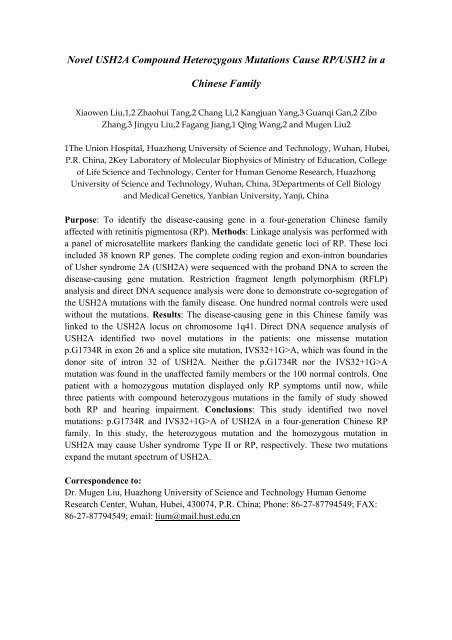New Modes of GPCR Signalling
New Modes of GPCR Signalling
New Modes of GPCR Signalling
You also want an ePaper? Increase the reach of your titles
YUMPU automatically turns print PDFs into web optimized ePapers that Google loves.
Novel USH2A Compound Heterozygous Mutations Cause RP/USH2 in a<br />
Chinese Family<br />
Xiaowen Liu,1,2 Zhaohui Tang,2 Chang Li,2 Kangjuan Yang,3 Guanqi Gan,2 Zibo<br />
Zhang,3 Jingyu Liu,2 Fagang Jiang,1 Qing Wang,2 and Mugen Liu2<br />
1The Union Hospital, Huazhong University <strong>of</strong> Science and Technology, Wuhan, Hubei,<br />
P.R. China, 2Key Laboratory <strong>of</strong> Molecular Biophysics <strong>of</strong> Ministry <strong>of</strong> Education, College<br />
<strong>of</strong> Life Science and Technology, Center for Human Genome Research, Huazhong<br />
University <strong>of</strong> Science and Technology, Wuhan, China, 3Departments <strong>of</strong> Cell Biology<br />
and Medical Genetics, Yanbian University, Yanji, China<br />
Purpose: To identify the disease-causing gene in a four-generation Chinese family<br />
affected with retinitis pigmentosa (RP). Methods: Linkage analysis was performed with<br />
a panel <strong>of</strong> microsatellite markers flanking the candidate genetic loci <strong>of</strong> RP. These loci<br />
included 38 known RP genes. The complete coding region and exon-intron boundaries<br />
<strong>of</strong> Usher syndrome 2A (USH2A) were sequenced with the proband DNA to screen the<br />
disease-causing gene mutation. Restriction fragment length polymorphism (RFLP)<br />
analysis and direct DNA sequence analysis were done to demonstrate co-segregation <strong>of</strong><br />
the USH2A mutations with the family disease. One hundred normal controls were used<br />
without the mutations. Results: The disease-causing gene in this Chinese family was<br />
linked to the USH2A locus on chromosome 1q41. Direct DNA sequence analysis <strong>of</strong><br />
USH2A identified two novel mutations in the patients: one missense mutation<br />
p.G1734R in exon 26 and a splice site mutation, IVS32+1G>A, which was found in the<br />
donor site <strong>of</strong> intron 32 <strong>of</strong> USH2A. Neither the p.G1734R nor the IVS32+1G>A<br />
mutation was found in the unaffected family members or the 100 normal controls. One<br />
patient with a homozygous mutation displayed only RP symptoms until now, while<br />
three patients with compound heterozygous mutations in the family <strong>of</strong> study showed<br />
both RP and hearing impairment. Conclusions: This study identified two novel<br />
mutations: p.G1734R and IVS32+1G>A <strong>of</strong> USH2A in a four-generation Chinese RP<br />
family. In this study, the heterozygous mutation and the homozygous mutation in<br />
USH2A may cause Usher syndrome Type II or RP, respectively. These two mutations<br />
expand the mutant spectrum <strong>of</strong> USH2A.<br />
Correspondence to:<br />
Dr. Mugen Liu, Huazhong University <strong>of</strong> Science and Technology Human Genome<br />
Research Center, Wuhan, Hubei, 430074, P.R. China; Phone: 86-27-87794549; FAX:<br />
86-27-87794549; email: lium@mail.hust.edu.cn












